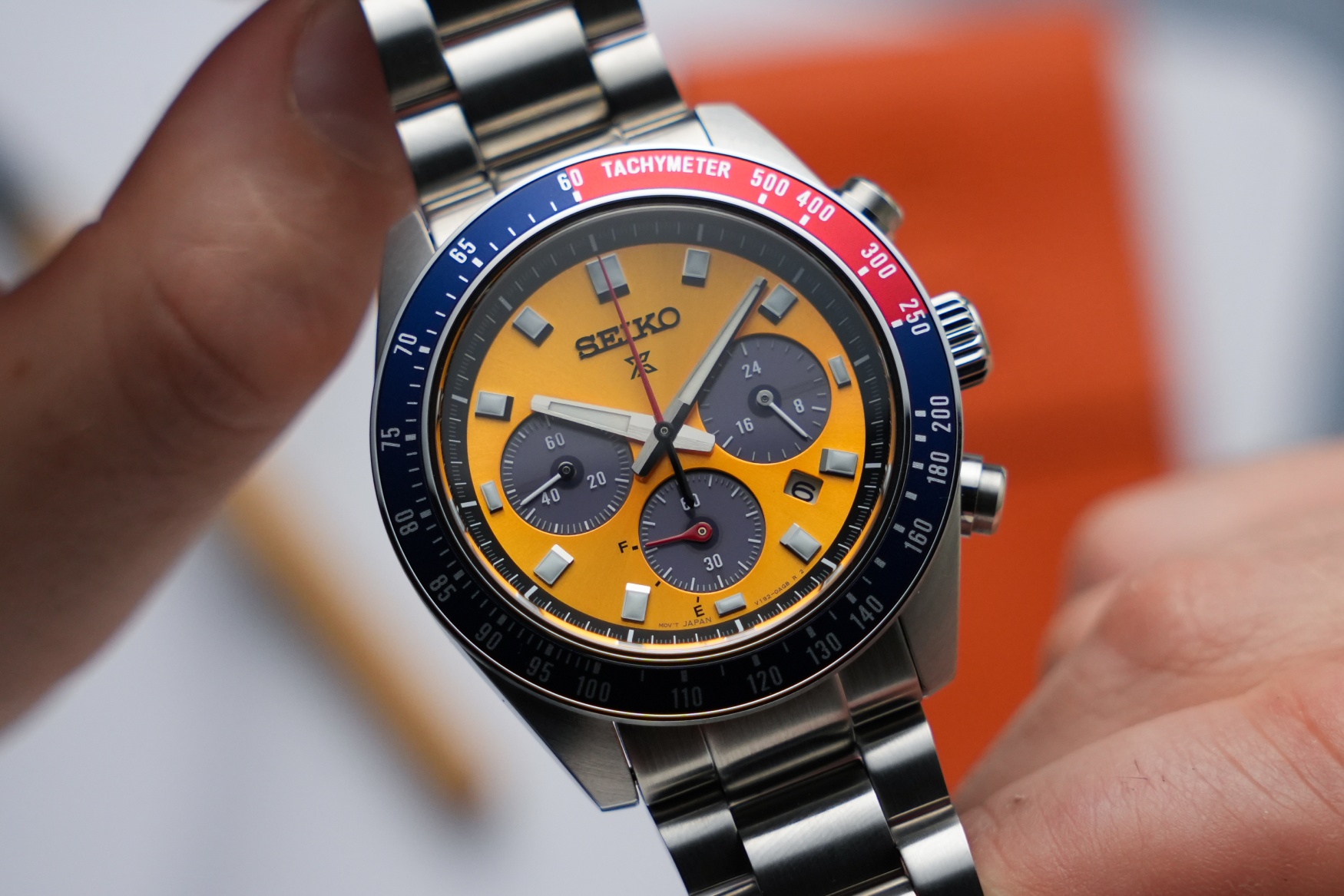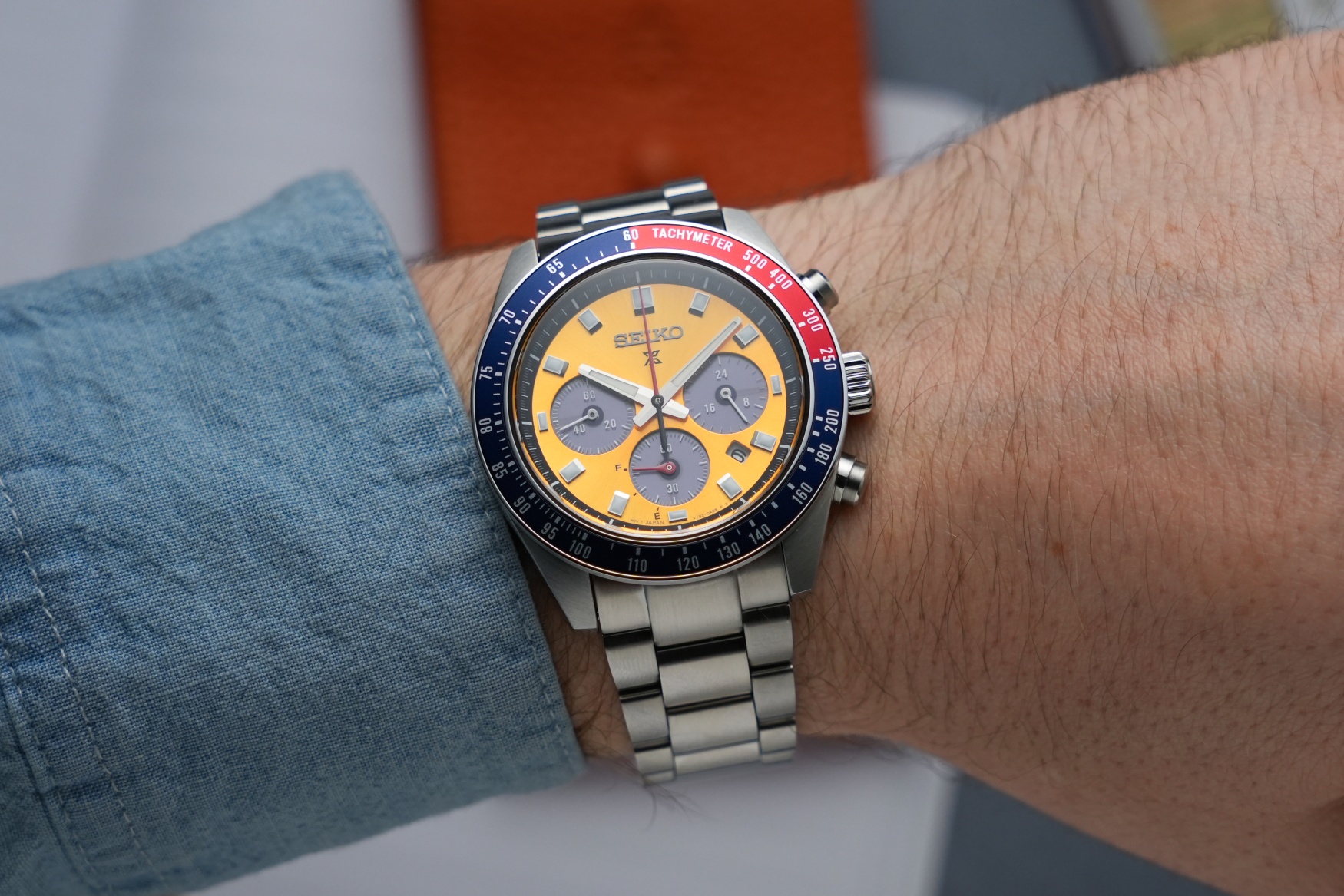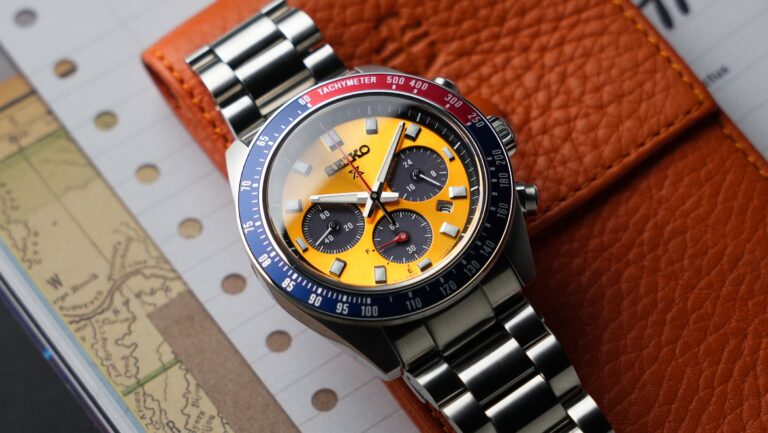Borna Bosniaks
There are several watch brands out there with incredibly strong fan bases, but one that always stands out is Seiko. Of course, I may be a bit biased because I’m a die-hard Seiko fan, but the way this brand has garnered such a cult following is truly unique. No watch in Seiko’s storied history has captured the spirit of its cult fans quite like the Pogue Speedtimer Chronograph. Renowned for its Pepsi bezel and gleaming gold dial, this model has become a cornerstone of vintage Seiko collections and is often proof that potential buyers have passed the point of no return. So what better color scheme could there be for the next version of the popular Seiko Prospex Speedtimer Chronograph? First released in 2021 as a Panda variant, then increased in diameter and sporting a colorful bezel closer to the 6139, the Prospex Speedtimer Pogue has finally adopted Seiko’s most revered color scheme. Let’s take a closer look.
A short history of the Pogues

But before we talk about the new watch, it’s worth digging into why the Pogue is so important in the world of Seiko. It’s not just the vibrant and eye-catching color combination, the original Seiko 6139 chronograph was the result of the brand’s participation in a three-way competition to see who would bring the first automatic chronograph to market. While the winner of this battle is generally accepted to be Zenith’s El Primero, which brought its chronograph to market in January 1969, Seiko’s 6139 examples date back as early as October 1968. In fact, for me, the intrigue of this legendary tale is not who the true winner was, but the mystique and twists of the story that make it worth exploring.


So it’s clear that the 6139 movement that powered the original Pogue model is historically significant, but why the gold dial in particular? It’s because of Colonel William Pogue, which is where the watch got its nickname. Originally selected to take part in the Apollo 19 mission (later canceled), Pogue was instead chosen to spend 84 days in space as part of the Skylab 4 mission. On his right wrist? An Omega Speedmaster, of course. But on his left wrist was a yellow-dial Seiko chronograph that he purchased for $71 on June 13, 1972. Because the watch was not approved by NASA, Pogue kept it in the leg pocket of his spacesuit and wore it once aboard, keeping Central Standard Time. And unlike many chronograph owners, he actually used the watch to time engine ignitions during pre-flight training, performed extravehicular activities during the mission, and continued to wear it until 2003.


The watch was sold at Heritage Auctions in 2008, where it sold for the astonishingly low price of $5,975. William Pogue passed away on March 3, 2014 at the age of 84, but his watch of choice has become legendary among Seiko and space watch enthusiasts.
Dial

Let’s start with the bright yellow dial, the highlight of the Prospex Speedtimer Pogue. The sunburst effect is nice and rich, but toned down by the black translucent sub-dials that let the sunlight through – after all, this is a solar-powered watch. What only Pogue aficionados will notice is the black rehaut, which is probably a tribute to the famous Aussie Pogue, a rare variation of the original 6139 with a black inner rotating bezel.
The chunky sword-shaped hands and chunky rectangular Lumibrite-coated markers are carried over from other Solar Prospex Speedtimer models, as is the date window at 04:15, which you can probably tell I’m not a huge fan of, but other additions, like the handy power reserve indicator that also doubles as the chronograph minute counter, are nicely integrated into the existing three-register layout.
Incident

As you would expect from a modern Seiko sports watch, the diameter and thickness are on the larger side, at 41.4mm wide and 13mm tall. These are nothing outlandish and are probably a step up from a classic 40mm diver’s watch. However, since this is a Seiko sports watch, the lug-to-lug length is a modest 45.9mm, which should suit most wrist sizes. The pushers and crown match the steel case, and the bezel insert is bi-colored aluminum. You could ask for a sapphire insert, but as this is a watch inspired by vintage models, you can’t really argue with that, and I don’t mind the blue and red aging beautifully.

As for the finishing, it’s a standard combination of polishing and brushing, with minimal polishing and just highlighting to avoid taking away from the inherent sportiness of the watch. Although the pushers are not screw-in, the Prospex Speedtimer Pogue is water resistant to 100 meters, 30 meters better than the original 6139. However, some of the older dials were marked “water resistant,” so you’ll have to judge for yourself.
bracelet

The three-link bracelet matches the mostly brushed look of the case and is a fairly standard three-link format, finished with a small push-button folding clasp with two micro-adjustment holes. This clasp, with its milled interior, is one of Seiko’s better clasps, but I have to admit that it’s not the bracelet’s strong point. Comfort-wise, there’s little to complain about, as the bracelet balances the fairly heavy watch body well. If you want to replace it, the 21mm lug width makes it a bit difficult, but with enough patience, you should be able to find a strap that fits (or tucks in at 22mm).
motion

Under the very basic screw-down caseback is Seiko’s V192 solar chronograph movement. Seiko claims it’s accurate to +/- 15 seconds per month and will last six months on a full charge. Solar quartz may not be the most romantic choice for such an emotional tribute piece, but it makes perfect sense when you consider the added cost of even the most affordable Seiko mechanical chronographs. For fans, Seiko has managed to maximize the practicality of a quartz movement by including solar charging capabilities.
Verdict

For a Seiko nerd like me, a watch like this Pogue revival or the previous Cevert-colored Speed Timer is just the thing. Sure, I don’t need a date window, and snobs would prefer something with a mechanical chronograph movement, but for someone who collects original Pogues and is looking for something easy to wear on a daily basis, I don’t think those are a big obstacle. With inflation going up and great affordable Seikos becoming harder to come by, the new Prospex Speed Timer SSC947 proves that the brand is still in tune with its fans.
Seiko Prospex Speedtimer Pogue SSC947 Price and Availability
The Seiko Prospex Speedtimer SSC947 will be available in October 2024. Price: $700 USD, $1,100 AU
Brand Seiko Model Prospex Speed Timer Reference SSC947 Case Size 41.4mm (D) x 13mm (T) x 45.9mm (LTL) Case Material Stainless Steel Water Resistance 100 meters Crystal Sapphire front Dial Sunburst yellow Lug Width 21mm Strap 3-link steel bracelet, folding clasp Movement V192, solar chronograph Power Reserve 6 months on a full charge Functions Hours, minutes, small seconds, chronograph, date, overcharge protection, 24-hour hand, power reserve Scheduled Release October 2024 Price 700 USD
1,100 Australian dollars
